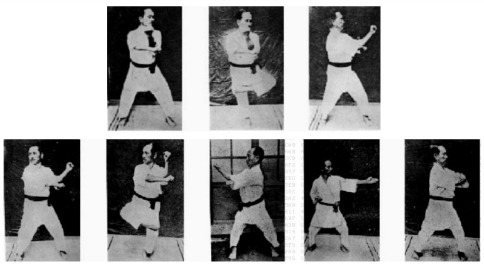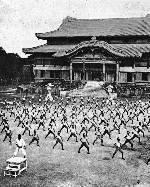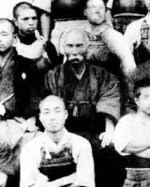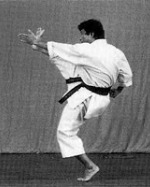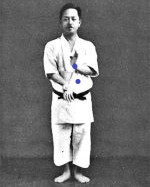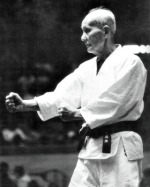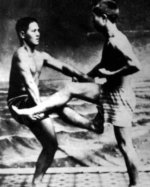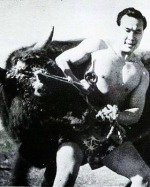The History of the Shotokan Kata – Part One
Talk the Talk
Kata is practised in most karate styles along with other Japanese fighting arts such as judo, aikido and kendo, though many of the Shotokan kata originate from Chinese martial
arts.
The word roughly translates to Form and denotes a set routine of movements of varying difficulty designed to practice all aspects of the art and can be executed
alone or as a team moving simultaneously.
Walk the Walk
In many styles of karate, low stances and exaggerated arm and leg movements are employed when executing the techniques making them seem unproductive to the untrained observer.
However, the basic moves and stances used in styles like Shotokan are in and of themselves a training method designed to strengthen the body and improve speed and technique.
As an example, the idea is that if you can train for a long period in low stances, in a situation when you need to defend yourself in a normal fighting stance, there is little
chance your legs will become tired and the extra muscle developed will help with the overall speed of movement.
Karate Quote
In the past, it was expected that about three years were required to learn a single kata, and usually even an expert of considerable
skill would only know three or at most five kata.
~ Gichin Funakoshi ~
~ Gichin Funakoshi ~
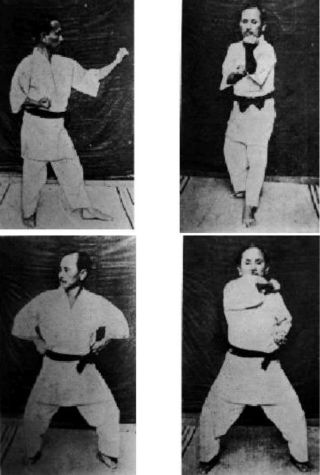
The History of Kihon Kata
Kihon kata (Basic Form) is, as the name suggests, the most basic of all the Shotokan kata consisting of just two techniques, gedan barai (lower block) and oi tsuki (lunge punch). Also known as Taikyoku Shodan, it was invented by Sensei Gichin Funakoshi and intended to be an easy introduction to kata and karate itself.
Originally it was the first of a set of basic kata that Funakoshi introduced, though in modern Shotokan it’s usually the only one taught and in more recent years, kihon itself has disappeared from the syllabus of many schools.
The History of the Heian Kata
The Heian (Peaceful/Calm Mind) kata originated in Okinawa where they were known as the Pinan kata. While many styles still use the Okinawan name (which means the same), in Shotokan they are usually known as the Heian kata, a name change instigated by the style’s founder Gichin Funakoshi when he introduced karate to Japan in the 1920s.
The set of kata was probably developed from much older forms of kung fu known as Chiang Nan and/or Kushanku (Kanku Sho and Dai may also originate from these kata) and later developed by the Okinawan Master Anko Itosu at the turn of the twentieth century.
According to legend, Itosu (or maybe his teacher Tode Sakugawa) was taught Chiang Nan (pronounced Channan in Japanese) by a Chinese diplomat and martial arts expert who lived in Okinawa called Kung Hsiang Chun. Though the original form is now lost, it is thought that it was extremely long so was divided up into five separate kata to make it easier to learn.
An alternative theory is that Master Itosu, who had taken the previously secretive martial art into the schools in Okinawa, found that children often had trouble learning the kata that were on the syllabus so he devised the Pinan kata group to aid this.
It is believed by some that he took moves from the Bassai and the Kanku sets in particular and arranged them so they gradually got more difficult through the various Pinan kata, allowing his younger students to progress from very basic moves to more advanced ones.
The kata known today in the Shotokan syllabus as Heian Nidan was originally the first of the Heian kata and therefore known as Heian Shodan. However sometime in the 1930s, Sensei Gichin Funakoshi switched Nidan and Shodan around though some styles still practice them in the original order. However what Shotokan karate calls Heian Shodan is arguably a lot easier to learn than Nidan, which is probably why they were switched in the first place.
The History of the Tekki Kata
The Tekki (Iron Horse) kata were derived from a single long kata called Naihanchi (Internal Divided Conflict) which was a part of the Shuri-te and Tomari-te karate styles in Okinawa and was the most basic kata before the introduction of the Pinan (Heian) kata set.
Anko Itosu is credited with developing the Tekki kata, though while some believe he invented Tekki Nidan and Sandan independently of Naihanchi, the fact that only Tekki Shodan has a formal opening move may suggest that they were all based on the Okinawan form.
There is further debate amongst martial arts scholars about what the pattern of the Tekki kata means, all of which follow a simple straight line in kiba-dachi (horseback stance). Some believe this represents fighting in a confined space with your back against the wall, others state that they are intended to develop skills for fighting on a boat while others still maintain that they were intended to represent fighting on horseback.
However, as the strength and skills developed through the Tekki kata would work for these and other situations, an outright definition is unnecessary as the application of kata should work for the individual karateka as opposed to being an absolute. Gichin Funakoshi considered them a very important part of the Shotokan syllabus and spent three years practising each of the Tekki kata, believing them to be difficult to master despite the fact that they are relatively short.
The History of the Bassai Kata
The Bassai (To Penetrate a Fortress) kata comes in many different versions, varying from one style of karate to the next and in Shotokan, there are two of them, Bassai Dai (Major/Large) and Bassai Sho (Minor/Small). Known as Passai in Okinawa, their history is obscure but they are believed to be derived from very old forms from China, then developed in Okinawa. A four-hundred-year-old silk drawing is thought by some to depict an early version of Bassai Dai, whose origins some believe can be traced back to either Leopard and Lion kung fu forms or from Five Element Fist kung fu.
When the earlier form arrived in Okinawa, it was taught to Master Sokon Matsumura, probably by a man named Oyadomari Peichin. In turn, Matsumura taught it to Anko Itosu who is often credited with creating Bassai Sho from Passai sometime in the late nineteenth century. The Bassai kata that are taught in Shotokan today are believed to have been designed to complement each other as the first, Bassai Dai, represents forcing your way into a fortress and the second, Bassai Sho, represents fighting your way out.
The History of Empi
There are three main scholastic theories on the origins of the kata Empi (Flight of the Swallow, also frequently transliterated as Enpi). The first is that it was brought to Okinawa in 1683 by a Chinese envoy named Wang Ji, an expert in Shaolin Fujian White Crane. The second suggests it was brought to Okinawa in the late fourteenth century by a group of immigrants from China known as the Thirty-Six Families, who brought with them new systems of martial arts that were taught to a select few on the island that were deemed worthy.
The third popular theory on the origins of Empi suggests it was developed more recently on the island itself as the kata was previously known as Wanshu, a name that could have come as a result of it being dedicated or even created by an Okinawan karate master by the name of Suppashi Wanshu.
Whatever its origins, it is possible though far from universally accepted that one of the main moves in the kata, the rising punch, was based on a sword technique of the samurai warrior Sasaki Kojiro, who had a particular move that was said to resemble the flight of a swallow. Kojiro was considered to be the finest swordsman of his day until he was famously defeated and killed in a duel by the legendary samurai Miyamoto Musashi in 1612.
What we do know is that by the nineteenth century, Wanshu was being taught by Kosaku Matsumura of the Tomari-te style who passed it down to Sokon Matsumura and Anko Itosu; the versions they practiced however varied suggesting that they independently developed what they were taught. Master Itosu taught his version to his student Gichin Funakoshi who went on to introduce it to Japan in the 1920s, changing the name from Wanshu to Empi in the process.
The History of Hangetsu
Hangetsu (Half Moon) came through the Naha-te school on Okinawa where it was known as Seishan (Thirteen). When the name was changed and by whom is unclear as in Sensei Gichin Funakoshi’s book, Ryukyu Kenpo Karate, it is listed under the name Seishan whereas others are listed under the new names he gave them. That said, he still may have been the one to make the change but did it later in his life.
It is believed that prior to being introduced to Okinawa, the kata’s history is very old and may even be the oldest of all the karate kata. One prevalent theory is that it came from a Chinese folk dance which aimed to explain the importance of the tides.
If this is the case, the name may be in reference to the thirteen-day intervals as the moon revolves around the earth and its effect on the tides. However, a more likely explanation is that it got its Okinawan name as a result of the fact there are thirteen moves in the kata (as long as you only count repeated techniques once).
Another theory on the origins of the kata Hangetsu is that it came from an old form practiced in Southern Chinese martial arts known as Four Gate Hands which is still practiced today in the Southern Praying Mantis Style. This seems more likely to be the case as the two training exercises are very similar, though this may denote that they share a common ancestry within the history of the martial arts rather than one deriving from the other.
The History of the Kanku Kata
The Kanku (Looking into the Sky) kata is a set of two forms (Sho/Minor and Dai/Major) that are practised by many styles including those of Japanese, Okinawa and Korean karate. Kanku Dai is the older of the two and was a particular favourite of Sensei Gichin Funakoshi, who used it extensively in demonstrations when he was in the process of introducing karate to Japan as he believed it held within it all the essential elements of karate. Originally called Kushanku, Funakoshi renamed it in the 1930s as, according to his student Masatoshi Nakayama, the new name reflected that the kata represented, amongst other things, modesty in karate.
Kushanku is thought to have been first introduced to Okinawa in the eighteenth century by a Chinese diplomat and kendo expert named Kung Hsiang Chun (pronounced Ku Shan Ku in the Okinawan dialect). He is thought to have passed it on to Tode Sakugawa of the Shuri-te school though an alternative theory is that it was Sakugawa who invented the kata and named it in honour of Kung Hsiang Chun.
The younger of the kata set, Kanku Sho, was probably invented in the nineteenth century by Anko Itosu. While, as is the case with the history of most of the Shotokan kata, there is no primary written evidence for this, it contains moves that are typical of kata that were developed by Master Itosu, such as double punches and moves that are designed to control and or disarm someone with a stick.
The History of Jion
Jion (Mercy) probably has its roots in kung fu and according to the acclaimed Shotokan Master Hirokazu Kanazawa, it was invented in the Jion Temple by the Buddhist monks there who were accomplished martial artists. This is backed up not only by the name but also by the fact that it begins with the left hand covering the right fist, a starting posture often used in some kung fu styles. It later spread to Okinawa where it became a part of the Tomari-te syllabus though some believe it was actually invented there by someone with a connection to the Jion temple.
The History of Ji’in
The kata Ji’in (Inverted Mercy) is no longer a part of the Japanese Karate Association (JKA) syllabus and along with Wankan, was left out of the Best Karate book series by Masatoshi Nakayama, which is seen as a definitive guide to Shotokan kata. Despite this, Ji’in is still widely taught by many other Shotokan associations as it is believed that it still has a lot to offer students and deserves its place in kata history.
Ji’in is often seen as a part of a kata group along with Jion and Jitte as they share the same starting position with the left hand covering the right fist. This may mean that Ji’in and Jitte share the same origins as Jion and come from the Chinese Jion Temple though this is mostly speculation as their origins are unknown. As with many other kata, when Funakoshi introduced it to Japan, he changed the name to Shokyo (Pine Shadow), however in this instance the new name did not stick and it was changed back to Ji’in.
The History of Jitte
According to Masatoshi Nakayama in his book, Best Karate, Volume 7, the name Jitte (Ten Hands) implies that one must develop the strength of ten men. However, an alternative theory on the meaning of the name is that it comes from the raised fists hand position from within the kata, which can be said to look similar to a type of Sai known as a Jitte that was used by the police force on Okinawa during the nineteenth century.
The kata’s history may be rooted in China which is suggested by the starting position of the left hand covering the right fist, a posture often utilised in kung fu though it could have been invented in Okinawa and just influenced by what are now seen as its sister kata, Jion and Ji’in. It was taught as a part of the Tomari-te syllabus and has elements of Gyaku-te grappling techniques. Its main function however is to teach the karateka to defend against weapons, especially the Bo Staff, while helping to develop pliable bones and muscles.
See Also - The History of the Shotokan Kata – Part Two
Written by Andrew Griffiths – Last updated 19/09/2023. If you like
what you see, consider following the History of Fighting on social media.
Further Reading:
Nakayama, M. 1981. Best Karate, Volume 7. Kodansha International. Japan.Shotokan Kata. [Internet]. 2013. The Shotokan Way. Available From: http://www.theshotokanway.com/shotokankata.html [Accessed August 20, 2015].
Shotokan Kata. [Internet]. 2013. UNH Shotokan Karate Club. Available From: http://unh.edu/karate [Accessed August 20, 2015].
More Karate History
Karate History Home
The history of karate begins in Okinawa, where martial arts were influenced by both kung fu from China, and the Japanese samurai. After weapons were banned on the island, unarmed combat techniques were developed into a style of fighting recognisable as traditional karate, which was further developed after being taken to Japan in the early twentieth century by Gichin Funakoshi.
The history of karate begins in Okinawa, where martial arts were influenced by both kung fu from China, and the Japanese samurai. After weapons were banned on the island, unarmed combat techniques were developed into a style of fighting recognisable as traditional karate, which was further developed after being taken to Japan in the early twentieth century by Gichin Funakoshi.
The History of Okinawan Karate
A look at the history of Okinawan karate and how it developed from the seventeenth century. Okinawan martial arts had influences from both the Japanese samurai and Chinese kung fu, as well as techniques unique to the island itself which over the years blended and evolved into the traditional karate styles that are practiced all over the world today.
A look at the history of Okinawan karate and how it developed from the seventeenth century. Okinawan martial arts had influences from both the Japanese samurai and Chinese kung fu, as well as techniques unique to the island itself which over the years blended and evolved into the traditional karate styles that are practiced all over the world today.
The Life and Legends of Anko Itosu
Anko Itosu was a legendary Okinawan martial artist and a pioneer in the development of karate history. He popularised many aspects of the fighting system through his Shuri-te style and helped increase the number of people who were permitted to learn it by bringing karate training out of secrecy, and even gained permission to teach it in Okinawan schools.
Anko Itosu was a legendary Okinawan martial artist and a pioneer in the development of karate history. He popularised many aspects of the fighting system through his Shuri-te style and helped increase the number of people who were permitted to learn it by bringing karate training out of secrecy, and even gained permission to teach it in Okinawan schools.
Gichin Funakoshi - Father of
Modern Day Karate
Gichin Funakoshi was born in Okinawa in 1868 and is known as the father of modern-day karate due to the innovations he made to Okinawan martial arts when he took it to Japan and popularised it with the people there. Not only did he found Shotokan karate, but he was also instrumental in spreading karate across the world.
Gichin Funakoshi was born in Okinawa in 1868 and is known as the father of modern-day karate due to the innovations he made to Okinawan martial arts when he took it to Japan and popularised it with the people there. Not only did he found Shotokan karate, but he was also instrumental in spreading karate across the world.
The History of the Shotokan Kata – Part Two
A look at the history of the more advanced Shotokan kata, including their origins, development, interesting facts and debated issues. This list of karate kata histories includes, Wankan, Gankaku, Meikyo, Chinte, Gojushiho Sho and Dai, Sochin, Nijushiho and Unsu, and includes video links to the relevant kata.
A look at the history of the more advanced Shotokan kata, including their origins, development, interesting facts and debated issues. This list of karate kata histories includes, Wankan, Gankaku, Meikyo, Chinte, Gojushiho Sho and Dai, Sochin, Nijushiho and Unsu, and includes video links to the relevant kata.
Kenwa Mabuni – Founder of Shito-Ryu Karate
Kenwa Mabuni started life as a sickly child but transformed himself into a strong warrior through the practice and dedication to the martial arts. Through his studies with
great karate masters such as Anko Itosu and Kanryo Higaonna, along with the kung fu master Woo Yin Gue, he was able to combine what he had learned and develop one of the four
major styles of traditional karate, Shito-Ryu.
Hironori Otsuka – Founder of Wado-Ryu Karate
Hironori Otsuka was a renowned master of jujitsu by the age of 28 before becoming a karate student under Gichin Funakoshi. He excelled and quickly rose through the ranks to become an assistant instructor, helping to develop training techniques in Shotokan karate. Later, Master Otsuka would brake away and form Wado-Ryu, one of the main four styles of traditional karate.
Hironori Otsuka was a renowned master of jujitsu by the age of 28 before becoming a karate student under Gichin Funakoshi. He excelled and quickly rose through the ranks to become an assistant instructor, helping to develop training techniques in Shotokan karate. Later, Master Otsuka would brake away and form Wado-Ryu, one of the main four styles of traditional karate.
The Real Mr Miyagi – Founder of Goju Ryu
Sensei Chojun Miyagi was an early karate master who studied martial arts in both China and his homeland, Okinawa. He earned his place in martial arts history when he used his knowledge to blend soft (or internal) with hard (or external) techniques to develop the style known as Goju-Ryu, which is considered one of the main four styles and is today widely practiced throughout the world techniques.
Sensei Chojun Miyagi was an early karate master who studied martial arts in both China and his homeland, Okinawa. He earned his place in martial arts history when he used his knowledge to blend soft (or internal) with hard (or external) techniques to develop the style known as Goju-Ryu, which is considered one of the main four styles and is today widely practiced throughout the world techniques.
Mas Oyama – Founder of Kyokushin Karate
Mas Oyama, founder of Kyokushin karate was one of the best karate masters of all time. He developed his body, mind and techniques through rigorous training and fought and won hundreds of full contact battles against fighters from many different martial arts styles. To test his skills further, he also went head to head with 52 bulls and was victorious in all, whether against man or beast.
Mas Oyama, founder of Kyokushin karate was one of the best karate masters of all time. He developed his body, mind and techniques through rigorous training and fought and won hundreds of full contact battles against fighters from many different martial arts styles. To test his skills further, he also went head to head with 52 bulls and was victorious in all, whether against man or beast.
The images on this site are believed to be in the public domain, however, if any mistakes have been made and your copyright or intellectual rights have been breeched, please contact andrew@articlesonhistory.com.

